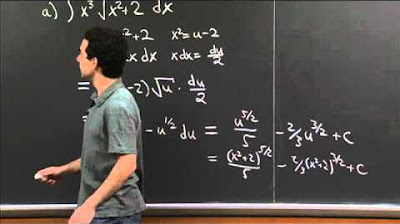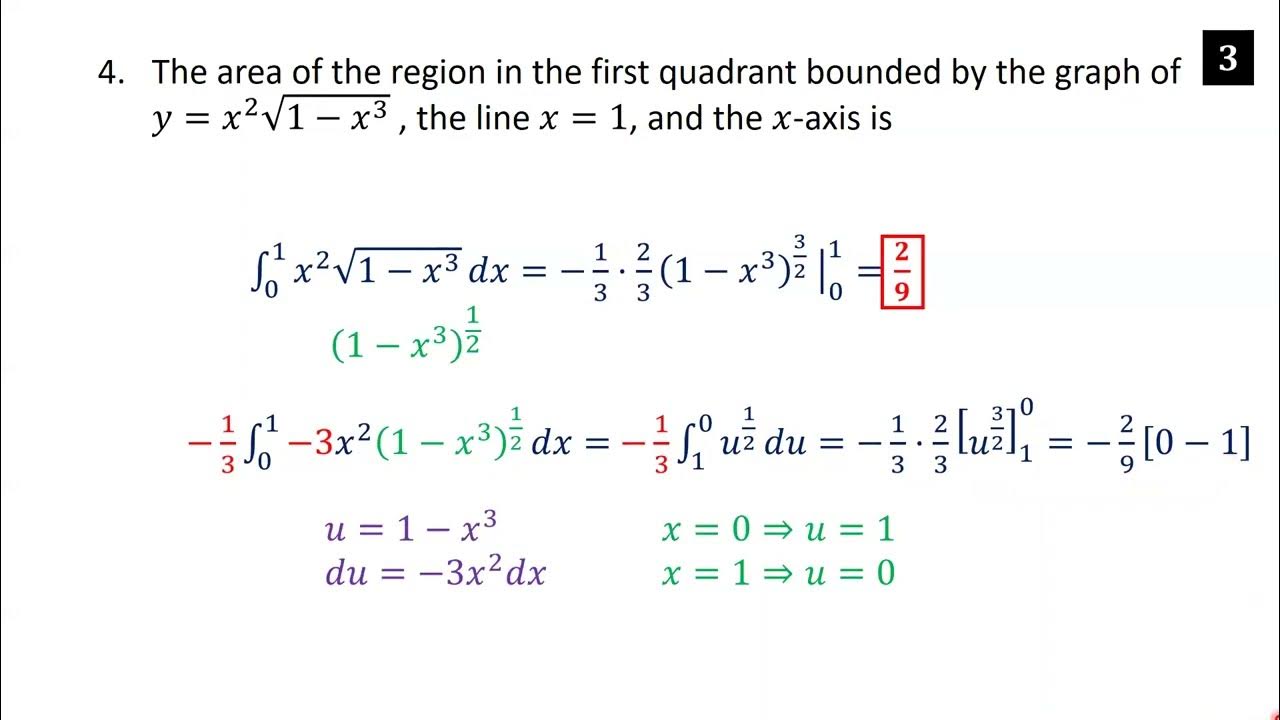Lesson 16- Integration By Trig Substitution (Calculus 1 Tutor)
TLDRThe video script discusses the method of integration by trigonometric substitution, a technique used to evaluate integrals that involve expressions under a square root. It emphasizes the importance of recognizing specific expressions, such as the square root of a squared minus x squared, which indicates the need for trigonometric substitution. The script provides a step-by-step guide on how to perform the substitution and introduces relevant trigonometric identities for each case. An example integral is used to illustrate the process, demonstrating how to identify the appropriate substitution and apply the method to solve the integral.
Takeaways
- 📚 The course section focuses on integration by trigonometric substitution.
- 🔍 Look for specific expressions to identify when to use trig substitution: √(a^2 - x^2), a^2 + x^2, and x^2 - a^2.
- 📝 Substitute x with appropriate trigonometric functions: a*sin(θ) for √(a^2 - x^2), a*tan(θ) for a^2 + x^2, and x = a*sec(θ) for x^2 - a^2.
- 🌟 Relevant trigonometric identities are crucial for the process: 1 - sin^2 = cos^2, 1 + tan^2 = sec^2, and sec^2 - 1 = tan^2.
- 🧠 Understand that the specific form of the integral guides the choice of substitution and the relevant trig identity.
- 📑 For the example integral ∫√(9 - x^2)/x^2 dx, recognize that it fits the pattern of √(a^2 - x^2) with a = 3.
- 👉 Perform the substitution: x = 3*sin(θ) and dx = 3*cos(θ)dθ.
- 📈 After substitution, the integral simplifies to ∫3/(3*sin(θ)^2) * 3*cos(θ)dθ.
- 🔄 The process involves replacing the original variables with the new trigonometric expressions and adjusting the differential accordingly.
- 📊 This method can be applied to a variety of integrals that fit the trigonometric substitution pattern.
- 🎯 Practice is essential to become proficient with these techniques, as the problems can become quite complex.
Q & A
What is the main topic of this section of the course?
-The main topic of this section is integration by trigonometric substitution.
What type of expressions should you be on the lookout for when using integration by trig substitution?
-You should be on the lookout for expressions like the square root of a squared minus x squared, a squared plus x squared, and x squared minus a squared.
What is the significance of the expression √(a^2 - x^2) in trigonometric substitution?
-The expression √(a^2 - x^2) indicates that you should use trigonometric substitution and substitute x with a times the sine of theta (x = a * sin(θ)).
How do you handle the expression a^2 + x^2 in trigonometric substitution?
-For the expression a^2 + x^2, you substitute x with a times the tangent of theta (x = a * tan(θ)).
What substitution is used for the expression x^2 - a^2?
-For the expression x^2 - a^2, you substitute x with a times the secant of theta (x = a * sec(θ)).
What is the relevant identity for the first case of trigonometric substitution (√(a^2 - x^2))?
-The relevant identity for this case is 1 - sin^2 = cos^2.
What identity is useful for the second case of trigonometric substitution (a^2 + x^2)?
-The useful identity for this case is 1 + tan^2 = sec^2.
How does the identity for the third case of trigonometric substitution (x^2 - a^2) relate to the others?
-The identity for the third case is sec^2 - 1 = tan^2, which is essentially the same as the second case's identity but for a different expression.
How do you identify the value of 'a' in the expression √(9 - x^2)?
-In the expression √(9 - x^2), 'a' is equal to 3, as the expression can be written as √(3^2 - x^2).
What is the derivative of x = a * sin(θ) with respect to θ?
-The derivative of x = a * sin(θ) with respect to θ is dx/dθ = a * cos(θ).
What is the final step in setting up the integral ∫√(9 - x^2)/x^2 dx after substitution?
-After substitution, the final step is to replace dx with 3cos(θ)dθ, which is the derivative of the trigonometric substitution in terms of θ.
Outlines
📚 Introduction to Integration by Trig Substitution
This paragraph introduces the concept of integration by trigonometric substitution, a method used to solve integrals that involve expressions under a square root. The instructor emphasizes the importance of recognizing specific expressions, such as the square root of a squared minus x squared, a squared plus x squared, and x squared minus a squared, which indicate the need for trig substitution. The paragraph also outlines the substitutions for these expressions: x as a times the sine of theta, a times the tangent of theta, and a times the secant of theta, respectively. Additionally, it introduces relevant trigonometric identities for each case, which are crucial for the integration process.
Mindmap
Keywords
💡Integration by Trig Substitution
💡Square Root
💡Trigonometric Functions
💡Substitution
💡Derivative
💡Relevant Identities
💡Sine Function
💡Tangent Function
💡Secant Function
💡Trig Substitution Patterns
💡Integral
Highlights
Integration by trig substitution is the focus of this course section.
The first expression to look for is the square root of a squared minus x squared.
For the expression a squared minus x squared, substitute x with a times the sine of theta.
When encountering a squared plus x squared, use a times tangent theta for substitution.
For x squared minus a squared, the substitution involves x equals a times the secant of theta.
The relevant identity for the first case is one minus sine squared equals cosine squared.
The identity for the second case is one plus tangent squared equals secant squared.
The third case uses the identity secant squared minus 1 equals tangent squared.
An example integral is provided: the square root of nine minus x squared over x squared.
The integral can be rewritten as the square root of 3 squared minus x squared over x squared DX.
The substitution in this example is x equals a sine theta, with a equals 3.
Derivative of x with respect to theta is three times the cosine of theta.
DX equals 3 cosine theta d theta after the substitution and derivative calculation.
The process involves writing down the expression, taking its derivative, and then performing substitution.
The integral kind takes the form of a squared minus x squared, indicating the substitution needed.
The method is applicable to integrals that contain expressions similar in form to the ones discussed.
Working through additional problems is encouraged to gain proficiency in this technique.
Transcripts
Browse More Related Video
5.0 / 5 (0 votes)
Thanks for rating:





